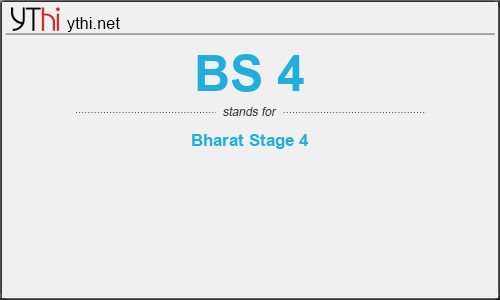What does BS 4 mean? What is the full form of BS 4?
The full form of BS 4 is Bharat Stage 4.
On July 4, 2014, India finalized the fourth stage of emission standards for motorized twowheeled vehicles. The Bharat Stage (BS) IV standards will go into effect for type approval
of new motorcycle models in April 2016, and for all motorcycle models in April 2017. The
new standards tighten the HC+NOX emission limits compared with the existing BS III
standards by 23%–60%, depending on motorcycle category. The other significant change
to the regulation is the adoption of the Worldwide Harmonized Motorcycle Test Cycle
(WMTC) as the mandatory test cycle. With this change, India has harmonized the testing
cycle as well as the definition of motorcycle categories as per United Nations Economic
Commission for Europe (UNECE) Global Technical Regulation 2 (GTR-2). In addition, the
new regulation establishes the first evaporative emission standards for two-wheelers
in India. Lastly, BS IV establishes that crankcase emissions form BS IV motorcycles are
prohibited from release into the atmosphere.
The Bharat Stage IV standards cover motorized two-wheeled vehicles with engine
displacement volume above 50 cubic centimeters (cc) and a maximum design speed
above 50 km/h (Vd > 50 cc, VMax > 50 km/h). Table 1 shows the Current BS III two-wheel
limits and the newly approved BS IV limits.
The most significant change in the regulation is the adoption of a new testing protocol.
Emission testing for Bharat IV will be carried out under the Worldwide Harmonized
Motorcycle Test Cycle (WMTC) following the United Nations Economic Commission for
Europe (UNECE) Global Technical Regulation 2 (GTR-2). The WMTC differs considerably
from the current BS III emission test cycle, the Indian Driving Cycle (IDC). The WMTC
better reflects real driving conditions, with higher maximum speed and steeper acceleration ramps than the IDC.
Another significant change is that BS IV defines independent NOX standards, in addition
to the combined HC+NOX limits. This requirement will force manufacturers to adopt
technology that specifically targets NOX, including electronic fuel injection, better
designed three-way catalyst systems, and, very likely, oxygen sensors.
Table 1 also shows European two-wheel standards (Euro 3 and Euro 4), for purposes
of comparison. Under the European regulation emissions are also measured with the
WMTC, but with some changes in the weighting factors. It seems that the proposed
Bharat IV standards for classes 1, 2-1 and 2-2, the most popular two-wheelers in India, fall
somewhere in between Euro 3 and Euro 4 for HC+NOX, but are ten years behind Euro 3
in terms of NOX limits.


Leave a Reply
You must be logged in to post a comment.